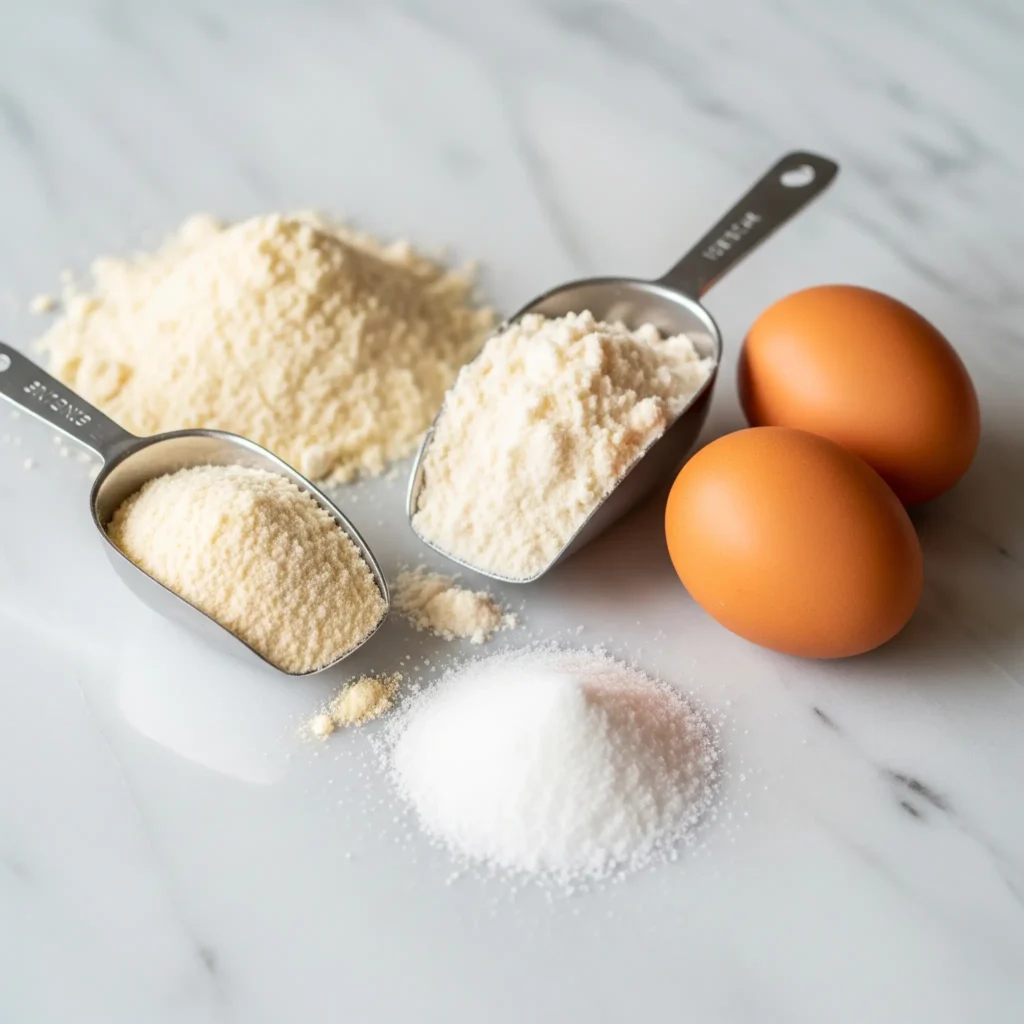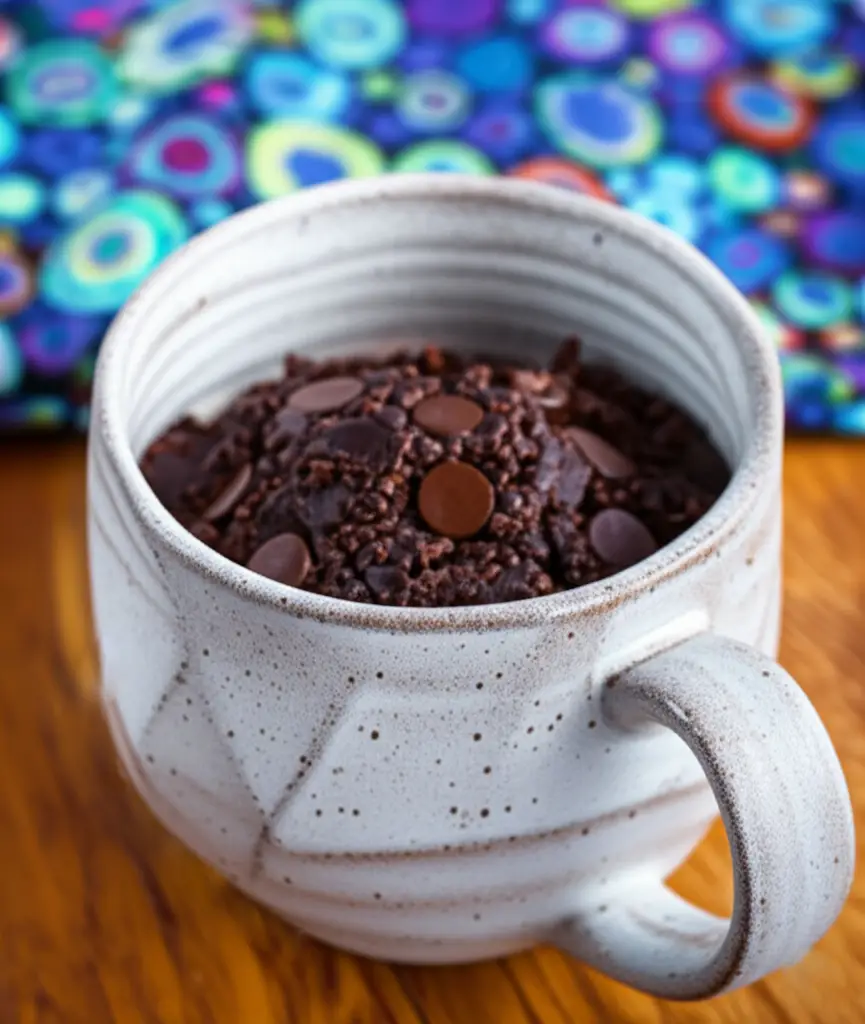Craving something sweet but still trying to stick to your low-carb lifestyle? You’re not alone. That’s where a keto mug cake recipe comes in—a game-changer for anyone on the ketogenic diet. This single-serving dessert takes just minutes to whip up, uses pantry staples like almond flour and sugar-free sweeteners, and delivers all the flavor without the guilt.
Whether you need a late-night treat, a quick breakfast-for-one, or a warm dessert on a lazy Sunday, this low-carb mug cake fits the bill. It’s rich, fluffy, and totally customizable with flavors like chocolate, peanut butter, and even Oreo-inspired variations.
Check out our easy and versatile Vanilla Mug Cake Recipe if you’re craving a classic flavor.
In this guide, you’ll learn everything from the basic ingredients to expert tips for moisture and texture, plus creative flavor variations. We’ll also answer your most common questions like “How many carbs are in a keto mug cake?” and “What can I use instead of flour?”
Let’s get baking—keto style.
Print
Keto Mug Cake Recipe
- Total Time: 1 minute
- Yield: 1 cup cake 1x
Description
This single-serving keto mug cake is incredibly soft, rich, and intensely chocolatey!
Ingredients
- 1/3 cup almonds or pecans, or 6 tbsp almond flour
- 1 tbsp + 2 tsp cocoa powder
- 1 tbsp granulated erythritol or sugar or sweetener of choice
- pinch stevia, or additional 2 tsp sugar
- 1/8 tsp salt
- 1/4 tsp baking powder
- 3 tbsp milk of choice, or 2 if using liquid sweetener
- 1/4 tsp pure vanilla extract
- optional chocolate chips or sugar free chocolate chips
Instructions
*If using almonds, grind them in a blender or food processor to achieve a flour-like consistency. It will be coarser than if you use almond flour (hence the almond pieces you can see in the photos), but both versions work.
Combine all ingredients in a greased ramekin or small mug. Either bake in a preheated 350F oven for about 10 minutes, or cook in the microwave. If microwaving, time will vary depending on wattage and desired gooeyness. I started with 30 seconds, then added two 15-second intervals after that. The cake will look a bit gooey when it comes out, and it firms up as it cools. But there’s no need to wait for it to firm up too much – this cake is meant to be eaten straight from the mug!
- Cook Time: 1 minute
Nutrition
- Serving Size: 1
- Calories: 195
- Sugar: 1.4g
- Sodium: 292mg
- Fat: 16.6g
- Saturated Fat: 1.6g
- Carbohydrates: 9.8g
- Fiber: 5.6g
- Protein: 7.7g
- Cholesterol: 0mg
Table of Contents
What Is a Keto Mug Cake Recipe?
Understanding the Basics of Keto and Mug Cakes
To fully appreciate a keto mug cake recipe, you need to understand the foundation it stands on. The ketogenic diet is a high-fat, moderate-protein, and very low-carb way of eating designed to help your body enter a state of ketosis—where fat is burned for fuel instead of carbs. This means traditional cakes made with flour and sugar are out of the question.
But that doesn’t mean desserts are off the menu.
Keto mug cakes are designed to satisfy your sweet tooth without breaking your carb budget. They’re usually made with almond or coconut flour, use sugar-free sweeteners like erythritol or monk fruit, and are often dairy-based to increase fat content. All of this happens in a single mug and takes just 60 to 90 seconds in the microwave.
A keto mug cake is:
- Low in net carbs
- Gluten-free
- Sugar-free
- Single-serve (no leftovers to tempt you)
- Ready in under 5 minutes
This makes them perfect for busy keto followers who don’t want to bake a full dessert just to satisfy a small craving.
Why Mug Cakes Are a Perfect Fit for Keto Lifestyles
Most people on keto struggle with one of two things: meal prep time and dessert cravings. A keto mug cake recipe solves both. It’s fast, portion-controlled, and completely customizable. More importantly, it doesn’t spike blood sugar, which is critical for maintaining ketosis.
Here are a few more reasons keto mug cakes are ideal for keto eaters:
- They’re low commitment. No need to heat up the oven or bake an entire cake.
- They’re budget-friendly. Most use basic ingredients you likely already have.
- They’re great for portion control. One serving means you’re less likely to overindulge.
- They’re flexible. Add-ins like cocoa, peanut butter, berries, or cream cheese can create endless variations.
If you’re living the keto life, mug cakes are more than a novelty—they’re a strategic dessert solution.
Ingredients That Make the Perfect Keto Mug Cake Recipe

Low-Carb Sweeteners: Erythritol, Monk Fruit & Stevia
When you’re baking on keto, traditional sugar is a no-go. But don’t worry—there are plenty of keto-friendly sweeteners that deliver sweetness without the carbs or the sugar spike.
Here are the top choices:
| Sweetener | Carb Count | Sweetness Level | Taste Notes |
|---|---|---|---|
| Erythritol | 0g net carbs | 70% as sweet as sugar | Slight cooling effect |
| Monk Fruit | 0g net carbs | 150–200% sweeter | Clean, sugar-like taste |
| Stevia | 0g net carbs | Up to 300% sweeter | Slight aftertaste for some |
Erythritol is a favorite for many because it measures similarly to sugar and has minimal impact on blood glucose. Monk fruit is often mixed with erythritol to balance sweetness and texture. Stevia, while very sweet, is usually used in drops or blends due to its intensity.
Pro Tip: When using powdered sweeteners, your cake will have a smoother texture. Granular ones can sometimes feel gritty unless fully dissolved.
Almond Flour vs. Coconut Flour: Which Works Best?
Flour alternatives are crucial to the structure of your mug cake. While traditional flour is rich in carbs, keto recipes rely on low-carb flours like almond or coconut.
Let’s break them down:
| Flour Type | Net Carbs (per 1/4 cup) | Texture | Absorbency |
|---|---|---|---|
| Almond Flour | 2g | Moist and nutty | Low |
| Coconut Flour | 6g | Dense and dry | High (absorbs lots of liquid) |
Almond flour is the go-to for most keto mug cakes. It gives a soft, cake-like texture and a mild flavor. Coconut flour, on the other hand, is much more absorbent. You’ll need far less of it and extra liquid or eggs to balance the dryness.
Which should you use?
- For a light, moist cake, almond flour is the winner.
- If you’re aiming for a denser, bread-like texture, go with coconut flour—but use it sparingly.
Looking for indulgence? Don’t miss our rich Oreo Mug Cake Recipe which combines both for the perfect balance.
Step-by-Step Guide to Making a Keto Mug Cake Recipe
Quick Instructions for a Classic Keto Mug Cake
Making a keto mug cake recipe is all about speed and simplicity. It’s the perfect low-carb dessert for when cravings strike, and you want something homemade—fast. Here’s a no-fail base recipe you can build on:
Ingredients:
- 3 tbsp almond flour (or 1 tbsp coconut flour)
- 1 tbsp unsweetened cocoa powder (optional, for chocolate)
- 1 tbsp erythritol or monk fruit sweetener
- 1/4 tsp baking powder
- 1 tbsp melted butter or coconut oil
- 1 egg
- 1/4 tsp vanilla extract
- 1 tbsp unsweetened almond milk (optional for moisture)
Instructions:
- Grab a microwave-safe mug or ramekin (10–12 oz is best).
- Add all dry ingredients: almond flour, cocoa powder, sweetener, and baking powder.
- Stir in melted butter, egg, vanilla, and almond milk. Mix well until smooth.
- Microwave on high for 60–90 seconds, depending on your microwave’s power.
- Let it rest for 30 seconds (it firms up as it cools).
- Top with sugar-free whipped cream, keto chocolate chips, or a dash of cinnamon.
Note: The batter should look thick but pourable. If it’s too stiff, add another teaspoon of almond milk.
Microwaving Tips for Even, Moist Results
Microwaves vary in wattage, so the key to a perfect mug cake lies in observation.
Here’s how to ensure even cooking and avoid rubbery results:
- Watch it rise. It should puff up around the 30-second mark—this means your leavening is working.
- Check for doneness. It’s done when the top is firm but springy. If the center is still wet, microwave it in 10-second intervals.
- Let it sit. Just like with regular baking, mug cakes keep cooking from residual heat for about 30 seconds after you take them out.
- Use the right mug. Ceramic or stoneware mugs with tall sides work best. Avoid glass or thin plastic.
Learn more about making cakes without eggs in our Mug Cake Recipe Without Egg if you’re exploring egg-free options.
For extra richness, stir in a square of sugar-free chocolate or a spoonful of peanut butter before microwaving—it melts into the center like lava.
Keto Mug Cake Variations to Try

One of the best things about a keto mug cake recipe is how easy it is to customize. Whether you’re craving rich chocolate, buttery peanut butter, or even cookies-and-cream inspired treats, there’s a flavor to match every mood—without kicking you out of ketosis.
Chocolate Keto Mug Cake
This is the most-loved variation for a reason. A rich, moist, and fluffy chocolate keto mug cake recipe hits all the right notes and pairs perfectly with a keto-friendly whipped cream or a drizzle of sugar-free syrup.
Simple Chocolate Mug Cake Additions:
- 1 tbsp unsweetened cocoa powder
- A few sugar-free chocolate chips
- Optional: 1/2 tbsp almond butter for a molten center
Flavor Boost Tips:
- Add a pinch of sea salt to enhance the chocolate flavor.
- Use instant coffee powder (1/8 tsp) to deepen the richness.
- For a nutty crunch, stir in chopped walnuts or pecans.
Microwave for 70 seconds, and you’ve got a gooey, brownie-like cake ready to devour.
Discover great ideas like the Mug Cake Recipe With Cake Mix if you’re looking for ultra-fast baking hacks.
Peanut Butter and Vanilla Flavor Twists
Not a chocolate fan? No problem. These two flavor profiles are both low-carb-friendly and high in healthy fats.
Peanut Butter Mug Cake
This variation is creamy, slightly salty, and deeply satisfying.
Add to your base recipe:
- 1 tbsp natural, unsweetened peanut butter
- 1/2 tsp cinnamon (optional)
- Chopped peanuts or crushed pecans for texture
Microwave for 60–70 seconds, and enjoy with a dollop of whipped coconut cream.
Vanilla Mug Cake
If you’re after a lighter, more delicate flavor, go with vanilla.
Use:
- 1/2 tsp pure vanilla extract
- Optional: 1/2 tsp lemon zest for a citrus twist
- Skip cocoa powder for a golden cake
Top with a few fresh raspberries or a dusting of powdered erythritol.
Try our lesser-known Mug Cake No Egg Recipe for an alternative that still delivers big flavor.
These easy twists allow you to stay keto while indulging your cravings—no need to sacrifice taste for macros.
Nutritional Breakdown of a Keto Mug Cake
When it comes to staying on track with a keto lifestyle, knowing your macros is key. A keto mug cake recipe not only delivers indulgent taste, but it also fits neatly into your low-carb goals—as long as you use the right ingredients and watch your portions.
How Many Carbs in a Typical Keto Mug Cake?
The exact net carb count of a keto mug cake recipe depends on what you put into it. However, a standard single-serve mug cake using almond flour and erythritol typically contains:
- Total Carbs: 7g
- Fiber: 3g
- Sugar Alcohols: 2g
- Net Carbs: 2g
Net carbs = Total carbs – fiber – sugar alcohols
So, most keto mug cake recipes contain just 2 to 4 net carbs per serving, making them a perfect dessert for those aiming to stay under 20–30g net carbs per day.
If you’re using coconut flour, the carb count might be slightly higher. Toppings like berries, chocolate chips, or syrups can also add more carbs—so be mindful of extras.
Calories, Protein, and Fat Analysis (with Table)
Let’s break down a classic keto mug cake made with the base recipe:
| Nutrient | Amount (Approx.) |
|---|---|
| Calories | 320 kcal |
| Net Carbs | 3g |
| Protein | 9g |
| Fat | 29g |
| Fiber | 4g |
| Sugar | 0g (with erythritol) |
This macro profile makes the keto mug cake a fat-forward treat that keeps you satisfied and supports ketosis. The high fat content from almond flour, butter, and egg makes it ideal for keeping hunger at bay while still enjoying a dessert.
If you’re tracking macros, you can also use apps like Carb Manager or MyFitnessPal to log each version of the cake, especially when you start experimenting with toppings or substitutions.
Looking for inspiration? Try more sweet creations from our homepage—loaded with low-carb dessert ideas that won’t ruin your progress.
Troubleshooting Common Keto Mug Cake Problems
Even though a keto mug cake recipe is easy to whip up, it’s not immune to kitchen mishaps. Sometimes your mug cake might turn out dry, rubbery, undercooked, or worse—bland. The good news? These issues are common and totally fixable.
Why Is My Mug Cake Dry or Rubbery?
A common complaint with mug cakes is the texture turning out more like a sponge than a cake. If your keto mug cake is rubbery, dense, or too dry, here’s what could be going wrong:
1. Overcooking
Microwaves vary in power. Cooking for 90 seconds in a high-wattage microwave can dry out your cake completely.
- Fix: Start with 60 seconds and increase in 10-second bursts only if needed.
2. Too Much Coconut Flour
Coconut flour is ultra-absorbent. Just an extra teaspoon can turn your mug cake into a brick.
- Fix: If you’re using coconut flour, reduce quantity to 1 tablespoon or less, and increase moisture with almond milk or an extra egg yolk.
3. No Fat Source
Fat adds moisture and richness. Using a low-fat milk alternative or skipping the butter can lead to dryness.
- Fix: Always include butter, ghee, or coconut oil in the recipe.
4. Insufficient Mixing
Clumps of almond flour or pockets of dry ingredients will affect texture.
- Fix: Mix thoroughly until batter is completely smooth.
The Secret to a Moist, Soft Mug Cake Texture
Getting that soft, bakery-style texture in your mug cake doesn’t require professional skills—it just takes a few tricks:
✅ Use Room Temperature Ingredients
Cold eggs or milk can cause uneven cooking and create a tough texture.
✅ Add Moisture-Boosting Ingredients
Incorporate these ingredients to amp up softness:
- 1 tsp sour cream or Greek yogurt
- 1 tbsp almond milk or heavy cream
- 1/2 tbsp nut butter (like almond or peanut butter)
✅ Incorporate Air
After you’ve mixed the batter, give it 2 minutes to rest. This allows the baking powder to activate slightly, resulting in a fluffier cake.
✅ Don’t Overbeat the Egg
Just mix until combined. Overmixing causes dense, chewy cakes.
Pro Tip: For extra indulgence, place a small square of dark sugar-free chocolate or a teaspoon of peanut butter in the center of the batter before microwaving—it melts into a gooey center that adds both flavor and moisture.
Learn more about baking tricks with our Mug Cake Recipe With Cake Mix for faster, more consistent results.
Flour & Sugar Substitutes in Keto Mug Cakes
One of the reasons keto baking is so unique (and sometimes tricky) is the absence of traditional baking staples like all-purpose flour and white sugar. Fortunately, there are fantastic low-carb alternatives that allow you to enjoy a rich, satisfying keto mug cake recipe without sabotaging your carb count.
What Can Replace Flour in a Mug Cake?
When you’re baking keto, flour isn’t just about bulk—it affects moisture, density, and flavor. Here are the most popular keto flour alternatives and how they perform in mug cakes:
Almond Flour
- Texture: Soft, slightly crumbly
- Flavor: Mild and nutty
- Ratio: Use 3 tbsp for most mug cakes
- Best for: Moist, cake-like results
Coconut Flour
- Texture: Dense and spongy if not balanced
- Flavor: Slightly sweet and coconutty
- Ratio: Use 1 tbsp max, plus extra liquid
- Best for: Those avoiding nuts
Protein Powder (Unflavored or Vanilla)
- Texture: Light but can dry out if overused
- Flavor: Neutral or sweet depending on type
- Ratio: Up to 1 tbsp to replace 1 tbsp flour
- Best for: Adding structure and protein boost
Ground Flaxseed or Chia Meal
- Texture: Slightly chewy and dense
- Flavor: Earthy and mild
- Ratio: Use 1 tbsp mixed with 2 tbsp water
- Best for: Egg replacement or flour filler
Each flour acts differently, so it’s best not to do a 1:1 substitution unless the recipe is designed for that flour. Blending almond flour with a touch of coconut flour often gives the best balance of texture and moisture.
Baking Without Sugar: Best Keto Alternatives
No sugar needed to savor the sweetness in your keto mug cake recipe. Keto-approved sweeteners give you all the flavor with none of the guilt. Here are your best options:
✅ Erythritol
- Zero-calorie, low glycemic impact
- Slight cooling aftertaste
- Great for baking and bulk
✅ Monk Fruit Sweetener
- 100–200x sweeter than sugar
- Often blended with erythritol
- No aftertaste, excellent for cakes
✅ Stevia
- Very concentrated
- Can be bitter in large amounts
- Best used in combo with other sweeteners
✅ Allulose
- Newer on the scene
- Acts like sugar in baking
- No impact on blood sugar or insulin
Pro Tip: Avoid artificial sweeteners like aspartame or sucralose—they’re not ideal for keto and can cause digestive issues.
When substituting, remember:
- Granular sweeteners mimic sugar’s bulk.
- Liquid drops (like stevia) need balancing to maintain structure.
- Powdered sweeteners dissolve better and create smoother textures.
Try our lesser-known Mug Cake No Egg Recipe to see how flour and sweetener combos work without eggs for even more flexibility.
Tools and Containers: What to Use for Best Results
Creating a perfect keto mug cake recipe isn’t just about the ingredients—it’s also about using the right tools. The wrong mug can cause overflow or uneven cooking, while the right mixing utensils ensure your batter comes out lump-free and airy.
Best Mugs and Bowls for Microwave Use
The right mug makes a big difference for your keto mug cake recipe; pay attention to its size and material. Here’s what to keep in mind:
✅ Size
- Use an 8 to 12 oz mug. Smaller mugs may cause batter to overflow, while oversized mugs may dry out the edges.
- Leave at least 1/3 of the mug empty to allow space for the cake to rise.
✅ Material
- Ceramic or stoneware mugs work best because they distribute heat evenly.
- Avoid thin glass or cheap plastic—they may not be microwave-safe and can cause inconsistent cooking.
✅ Shape
- A taller mug with straight sides allows the cake to rise without spilling.
- Wide, shallow mugs often cook the outside too fast while leaving the center undercooked.
✅ Ramekins and Bowls
If you want a more plated presentation or are baking for two, use a microwave-safe ramekin or shallow bowl. These cook more evenly and can be served restaurant-style.
Looking for more creative ways to serve your mug cakes? Try our Vanilla Mug Cake Recipe—perfect for elegant presentation.
How to Avoid Overflow and Uneven Cooking
Even if your batter is perfect, the wrong cooking method can ruin your mug cake. Follow these tips to avoid mess and get a consistent, fluffy result:
Don’t Overfill Your Mug
Only fill the mug half to two-thirds full. The batter needs room to expand as it cooks.
Mix Well
Make sure all ingredients—especially baking powder—are fully incorporated. Even small clumps can affect how the cake rises.
Let the Batter Rest
Allowing the mixed batter to rest for 1–2 minutes helps the baking powder activate, which leads to a fluffier rise.
Use a Microwave Cover
If your mug cake tends to bubble over, cover loosely with a microwave-safe plate or parchment paper to catch spills.
Stir Midway (Optional)
For older or lower-wattage microwaves, you can stop halfway through and stir once for even cooking, then finish microwaving.
Pro Tip: If your cake always ends up dry on the edges and gooey in the middle, try reducing power to 70–80% and microwave a bit longer for more even heat distribution.
Creative Serving Ideas for Your Keto Mug Cake

A keto mug cake recipe is already a satisfying solo dessert, but dressing it up with the right toppings and sides can turn it into a five-star keto treat. With the right presentation, flavors, and textures, your humble mug cake transforms from a microwave snack to a crave-worthy dessert.
Low-Carb Toppings and Add-Ons
Just because you’re keeping it keto doesn’t mean your mug cake has to be plain. Here are some flavorful and keto-safe toppings that add flair without piling on the carbs:
Sugar-Free Chocolate Chips
- Stir a few into the batter before cooking or sprinkle on top while warm to melt slightly.
Whipped Coconut Cream
- Chill coconut milk overnight, scoop the thick cream, whip with a little monk fruit, and serve dolloped on top.
Fresh Berries
- A few raspberries or sliced strawberries go a long way. Stick to 3–4 pieces to keep carbs in check.
Nut Butter Drizzle
- Warm peanut butter or almond butter adds creamy richness. One teaspoon swirled on top makes a huge difference.
Sea Salt Flakes
- A small sprinkle over chocolate mug cake brings out deeper, richer cocoa flavor.
Chopped Nuts or Coconut Flakes
- Add crunch and texture with toasted pecans, walnuts, or unsweetened coconut flakes.
Pairing with Keto Ice Cream or Coffee
Your mug cake doesn’t need to stand alone. Pair it with something complementary for a well-rounded dessert experience.
✅ Keto Ice Cream
- Serve warm mug cake with a scoop of low-carb vanilla or chocolate ice cream for contrast in temperature and texture.
✅ Bulletproof Coffee
- A rich mug cake and creamy butter coffee is the ultimate keto combo—perfect for an indulgent breakfast or late-night treat.
✅ Iced Keto Lattes
- Try an iced almond milk latte sweetened with monk fruit alongside a peanut butter mug cake.
Don’t miss our Mug Cake Recipe With Cake Mix for even more fast and flexible flavor combinations.
With these serving suggestions, your keto mug cake isn’t just a dessert—it’s an experience. Warm, rich, indulgent, and still 100% keto-approved.
FAQs: Answering Popular Questions
How many carbs are in a keto mug cake?
Most keto mug cake recipes contain between 2 to 4 net carbs per serving. The exact number depends on ingredients like flour type (almond vs. coconut), sweeteners, and add-ins. Always subtract fiber and sugar alcohols from the total carb count to get net carbs. Stick with almond flour and erythritol to keep your carb count ultra-low.
How to make mug cake with no sugar?
To make a sugar-free mug cake, use keto-approved sweeteners like erythritol, monk fruit, stevia, or allulose. These alternatives don’t spike blood sugar and are zero or low in net carbs. You can also add flavor with vanilla extract, cinnamon, or a hint of lemon zest to make up for the lack of real sugar.
What is the secret to moist mug cake?
The key to a moist keto mug cake recipe is balancing your fats and liquids. Use room temperature eggs, melted butter or coconut oil, and a touch of unsweetened almond milk or heavy cream. Don’t overcook it—microwave for 60–70 seconds, then let it rest. Want extra gooeyness? Add a dollop of peanut butter or sugar-free chocolate before cooking.
What can replace flour in a mug cake?
You can replace flour in a keto mug cake with:
Coconut flour (use less and add more liquid)
Protein powder
Chia seed meal
Ground flaxseed
Each option has different absorbency and flavor, so start small and adjust. Almond flour remains the most popular due to its taste and texture, but blending alternatives can offer unique results.
Conclusion: Why Keto Mug Cake Is the Best Low-Carb Dessert Fix
Whether you’re craving chocolate at midnight or need a dessert that won’t kick you out of ketosis, the keto mug cake recipe is your go-to fix. It’s fast, flexible, and completely customizable. Plus, it requires only a few ingredients, minimal cleanup, and delivers maximum satisfaction.
From classic vanilla to decadent chocolate and peanut butter swirls, keto mug cakes let you indulge—without the guilt. They’re a staple in every low-carb kitchen, perfect for beginners and seasoned keto followers alike.
So next time the sweet cravings hit, skip the processed snacks. Instead, make a delicious, fluffy mug cake right in your microwave—and stay keto strong.
Looking for inspiration? Try more sweet creations from our homepage and explore new ways to enjoy guilt-free desserts every day.

